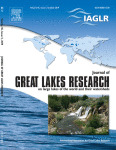European frogbit (Hydrocharis morsus-ranae) invasion facilitated by non-native cattails (Typha) in the Laurentian Great Lakes
Item
Title
European frogbit (Hydrocharis morsus-ranae) invasion facilitated by non-native cattails (Typha) in the Laurentian Great Lakes
Loyola Faculty Contributor
Andrew M. Monks
Link
List of Authors
Andrew M. Monks; Shane C. Lishawa; Kathryn C. Wellons; Dennis A.Albert; Brad Mudrzynski; Douglas A.Wilcox
Abstract
Plant-to-plant facilitation is important in structuring communities, particularly in ecosystems with high levels of natural disturbance, where a species may ameliorate an environmental stressor, allowing colonization by another species. Increasingly, facilitation is recognized as an important factor in invasion biology. In coastal wetlands, non-native emergent macrophytes reduce wind and wave action, potentially facilitating invasion by floating plants. We tested this hypothesis with the aquatic invasive species European frogbit (Hydrocharis morsus-ranae; EFB), a small floating plant, and invasive cattail (Typha spp.), a dominant emergent, by comparing logistic models of Great Lakes-wide plant community data to determine which plant and environmental variables exerted the greatest influence on EFB distribution at multiple scales. Second, we conducted a large-scale field experiment to evaluate the effects of invasive Typha removal treatments on an extant EFB population. Invasive Typha was a significant predictor variable in all AIC-selected models, with wetland zone as the other most common predictive factor of EFB occurrence. In the field experiment, we found a significant reduction of EFB in plots where invasive Typha was removed. Our results support the hypothesis that invasive Typha facilitates EFB persistence in Great Lakes coastal wetlands, likely by ameliorating wave action and wind energy. The potential future distribution of EFB in North America is vast due in part to the widespread and expanding distribution of invasive Typha and other invading macrophytes, and their capacity to facilitate EFB's expansion, posing significant risk to native species diversity in Great Lakes coastal wetlands.
Date
1-Oct-19
Publication Title
Journal of Great Lakes Research
Publisher
Elsevier
Identifier
10.1016/j.jglr.2019.07.005
Bibliographic Citation
Monks, A. M., Lishawa, S. C., Wellons, K. C., Albert, D. A., Mudrzynski, B., & Wilcox, D. A. (2019). European frogbit (Hydrocharis morsus-ranae) invasion facilitated by non-native cattails (Typha) in the Laurentian Great Lakes. Journal of Great Lakes Research, 45(5), 912-920. https://doi.org/10.1016/j.jglr.2019.07.005

